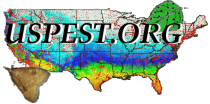

Dollar Spot disease is a disease of managed turfgrass, including golf courses, caused by the fungus Clarireedia jacksonii (formerly Sclerotinia homoeocarpa). Symptoms commonly appear as patches which are 1-3 inches across, round, white or light yellow, and often sunken. Patches may coalesce to form larger, irregular areas of blighted turf. On mornings when dew is present, and the fungus is active, there may be a white, cob-web-like growth of fungal mycelium present. Individual leaves that are infected are white to straw colored, often with tan or reddish brown margins. Dollar spot can readily develop resistance to fungicides, so consider applying them in rotation according to fungicide class (FRAC codes), according to label directions, and only during periods of high risk such as when indicated by weather conditions.
The disease appears at temperatures between 60-90°F during seasons with warm days, cool nights, and long periods of dew. The Dollar Spot app uses a five-day moving average of temperature and humidity to predict periods of favorable weather for development of the disease. The model assumes that turf grasses are susceptible (some new cultivars have lower levels of susceptibility), and that inoculum is present, which should be in evidence based on the appearance of symptoms mentioned above.
This app is a newer, streamlined interface for the existing model, which is also available through MyPest Page.
Select the "Inputs" tab, search for weather stations near you, and choose one either from a list or a map. Be aware that some weather stations have poor quality or missing data. Our software estimates the quality of each station, but you may wish compare results for several nearby stations.
Optionally, you may choose a start date and a span (number) of days. If you leave the start date blank, the end of the output will be five days in the future, using forecast weather data, and the app will count back to a start date in the recent past. The weather forecast data is from the National Weather Service's "NDFD" forecasts.
Then, select "Graph" or "Table" to run the model. Your output will appear after 10-20 seconds depending on server load.
The model predicts epidemic risk of Dollar Spot disease from temperature and relative humidity. It is most likely when warm, humid weather is sustained for several days. This model, developed by Smith, Kerns, et al., 2018 (available here: https://journals.plos.org/plosone/article?id=10.1371/journal.pone.0194216), estimates the probability of an epidemic occurring. Action is generally recommended when the probability exceeds 20%.
Technical information about the Dollar Spot disease and this model is available on our disease risk model documentation page.
Disclaimer: The index is intended to inform your decisions about management actions, such as choice and timing of control measures and intensity of scouting. It should supplement, not replace, the other factors you consider in making these decisions. Use at your own risk.
Automated email delivery of the disease risk index outputs displayed in this app is available at no cost. An email subscription offers model results for this and several other plant disease models, for up to three weather stations, on a schedule that you select. To subscribe, you will need a uspest.org account.
Next, use one of these buttons to run the model and see the output in the form of your choice.
To get this information by email, log in to or sign up for USPEST.org email notifications. To see the model output together with relevant weather inputs, go to MyPest Page.
To get this information by email, log in to or sign up for USPEST.org email notifications. To see the model output together with relevant weather inputs, go to MyPest Page.